Don’t let the “pre” part fool you, preeclampsia is a potentially fatal disease that affects about 5% of all pregnancies. Learning the signs of this “scarier than it sounds” condition can help save both your life and that of your baby.
May is Preeclampsia awareness month, but for someone who has dealt with this condition that can occur during pregnancy, every month is a good time to spread the word about it. It doesn’t sound like a really scary condition by the name. I mean, it’s a “pre” condition, right? Which means it comes before the really, really scary issue. Yes, that’s true, but preeclampsia can be just as dangerous on its own without ever evolving into eclampsia. Believe me, I know.
What’s so scary about Preeclampsia?
To understand why the condition is so scary, you have to know a little about it. Before my pregnancy, I’d heard of friends who developed preeclampsia during pregnancy, but never really gave it a whole lot of thought. So their blood pressure went up a bit? What was the big deal? I mean, sure, that’s not good, but really, my blood pressure goes up when I see clowns, so it can’t be all that bad, right?
For some women, preeclampsia can be as minor as a slight increase in blood pressure and a little swelling. When it occurs close to the end of the pregnancy, inducing labor and delivering your baby usually takes care of the problem. However, preeclampsia can occur at any time after the 20th week of pregnancy, according to PubMed Health (so you know I didn’t just make that up). For me, it came on at about 28 weeks. That’s when I noticed my feet looked like Fred Flintstone’s, and I could leave dents in my legs about 1/2 inch deep when I pressed. It wasn’t diagnosed, however, until I was 32 weeks along. I didn’t get any further than that.
Just why is it so scary? Well, for one thing, it can kill you. Anything that can kill you is scary! It can also kill your baby. If it doesn’t kill you, it can cause seizures and kidney failure. Fun, right? Other potential complications include bleeding disorders, a ruptured liver, placenta separation and stroke. I should note that PubMed Health claims that death is rare. When a doctor is yelling in your face that you could have a stroke and die if you don’t stop demanding they take you off the wretched “Mag” drip, it doesn’t sound like a rare complication. More on that later.
Who can get preeclampsia?
Basically, any pregnant woman is at risk for preeclampsia. It’s not really a condition that discriminates. However, there are certain risk factors that can increase the likelihood of developing this condition. These include being a first time mom, being pregnant with more than one baby, being overweight or over the age 35. Having a history of high blood pressure, heart disease and diabetes can also up your risk.
I was a first-time mom when I developed preeclampsia. I was also overweight before I got pregnant. While those two things alone aren’t enough to guarantee the condition, they were factors.
What causes preeclampsia?
Ha! That’s the burning question, isn’t it? I mean, if they could figure that out, they could decrease the risk quite a bit, right? Alas, no one really knows. Sure, there are theories. Some say it’s caused by an allergy to your partner’s sperm. Others say eating the wrong foods can cause it. There are countless theories, but no real answers. Researchers are making breakthroughs in discovering the real cause of preeclampsia, but despite excitement over the research, it’s still just a theory.
How do you know if you have preeclampsia?
I knew because my whole body- practically from head to toe, including my face- swelled up like an overfilled water balloon. It was confirmed when I went in for a routine appointment at 32 weeks and my blood pressure was 185/110. A simple test revealed that I was dumping +4 protein into my urine. That’s not good. You shouldn’t have any little pluses there. Basically, my results indicated imminent kidney failure. Other symptoms include:
- Nausea and vomiting
- Persistent Headaches
- Lower back pain (which could also be related to the baby laying on your sciatic nerves or your rapidly expanding belly!)
- Sudden weight gain (I gained 35 pounds in two weeks, all water)
- Blurred vision or other vision changes
- Decreased desire to pee. This did not happen to me though, partially because my son kicked my bladder into action every five minutes.
My personal preeclampsia story
In my birth story, I shared how Jacob was born at 32 weeks because of my preeclampsia. When it happened to me, I have to admit that I kind of suspected it the day I went in for that routine visit. I had only come to the conclusion that it was preeclampsia two days before, during a particularly bad night of vomiting, headaches, and thinking I was going to die. I was far from home, though, in Florida at the time, and it went away after about 8 hours. I think taking a decongestant had something to do with it.
Weeks before that day, I called the on-call doctor to let her know that I was concerned about my pitting swelling. She blew me off. She told me it was normal and just wear some compression socks. I pushed, saying I was concerned, and she still said it was nothing. No need to come in. I should have listened to my instincts.
When I went in for my visit, the first thing they did was take my blood pressure. As I said, it was 185/110. Normal blood pressure for me at that time was about 110/70-ish. Then they did the urine test. Less than a minute later, I was being ushered to the exam room and told to lay on my left side and not move. Less than 10 minutes later, they had me admitted to the hospital across the street. Less than 36 hours later, my son was born via emergency c-section to save both our lives.
What to expect if you develop severe preeclampsia
The only “cure” for preeclampsia is to deliver your baby. If you are far enough along, your OB may recommend early delivery, either through induced labor or c-section. I had to have the c-section because Jake was full breech with a low heart rate and I was in really bad shape. I couldn’t have made it through labor and delivery, and neither could he.
Before all that happened, I was hooked up to a bunch of machines to monitor my blood pressure. That cuff went off like every 15 minutes. Jacob was also monitored, and hearing him kick at the band around my waist plus the sound of his heartbeat was both soothing and maddening. Soothing because it meant he was alive. Maddening because it is almost impossible to sleep when your baby won’t stop thumping around loudly in your uterus! Of course, sleep wasn’t really easy anyway that first night.
I was hooked up to an IV containing magnesium sulfate drip to prevent seizures. That stuff sucks. I’m sorry, I know it saved my life, but it flat-out sucks. I’ve heard some people say it’s not so bad after the first few days. It made me vomit profusely and feel like every muscle in my body was turning to stone by the second day. I hated it. I screamed and cried on it because I hated it so much. The doctor yelled at me, and I cried more. Begged them to take me off it, but ultimately let them talk me into staying on it for nearly a whole 24 hours after Jacob was born. It was necessary, but horrible. Don’t let that freak you out, though. I have weird, rather extreme reactions to many medications, so it could have just been me.
What to expect after delivery
While delivering your baby is the only cure for preeclampsia, that doesn’t magically mean everything gets better the moment your baby is evicted from your womb. For me, my blood pressure remained high for a good 6 weeks after. I also had complications from my c-section, so that could have played a role. It wasn’t as high as it was the day before my son was born, but it still stayed dangerously high.
As for the 35 pounds of water weight, I lost that in about a week. My doctor told me that because of how early it came on, I was at a higher risk for developing preeclampsia with a second baby. About a 60% chance. My journey to conceiving, Jacob’s birth, and the complications after were so traumatizing to me that I never really cared to repeat the experience and test that theory. I’m good with just one kid, thank you very much.
What you should take away from this post
It was long, I know. I’m summing it up for you here. There are a few key points that I want you to take away, especially if you are pregnant or planning to become pregnant.
- Preeclampsia can happen to anyone.
- Regular prenatal checkups are vital.
- Trust your instincts and never let a doctor blow you off.
- The severity ranges, so don’t let my story freak you out. Just let it be a cautionary tale. Mine was far from the worst preeclampsia story, but it was also far from the mildest.
- TRUST YOUR INSTINCTS! Sorry, I thought that deserved repeating.

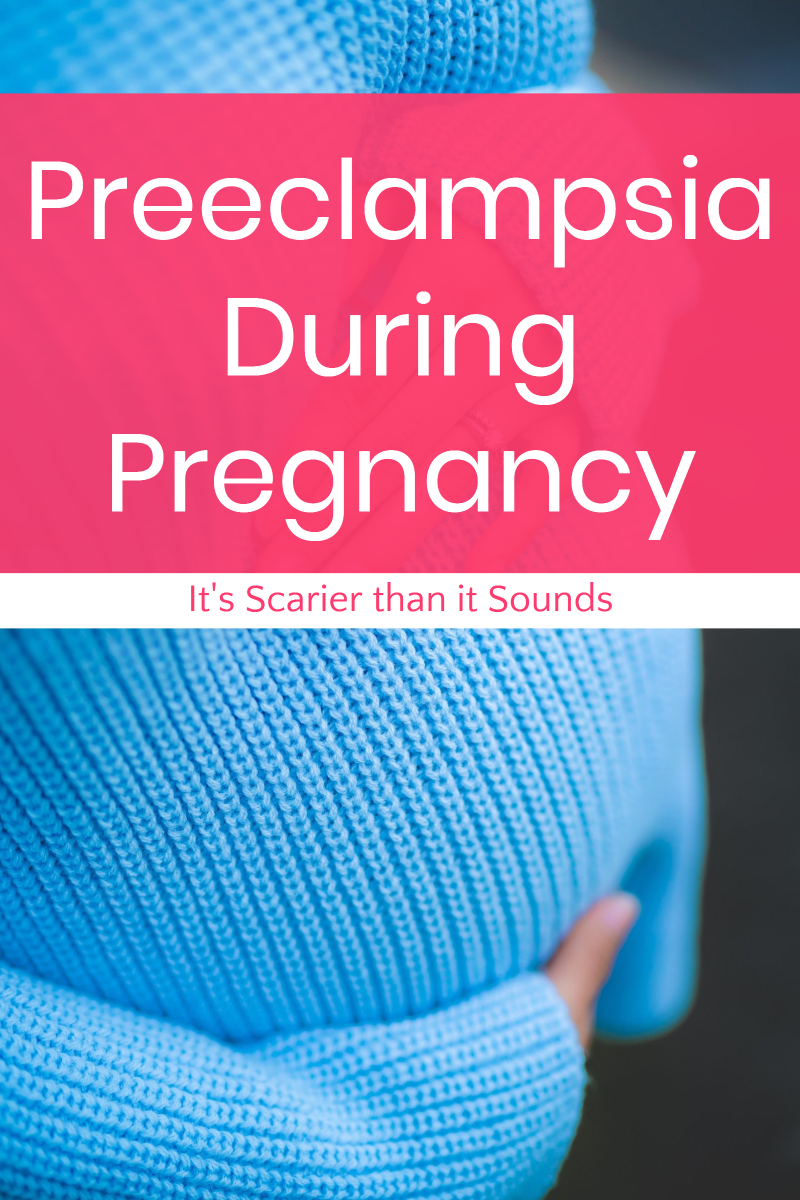
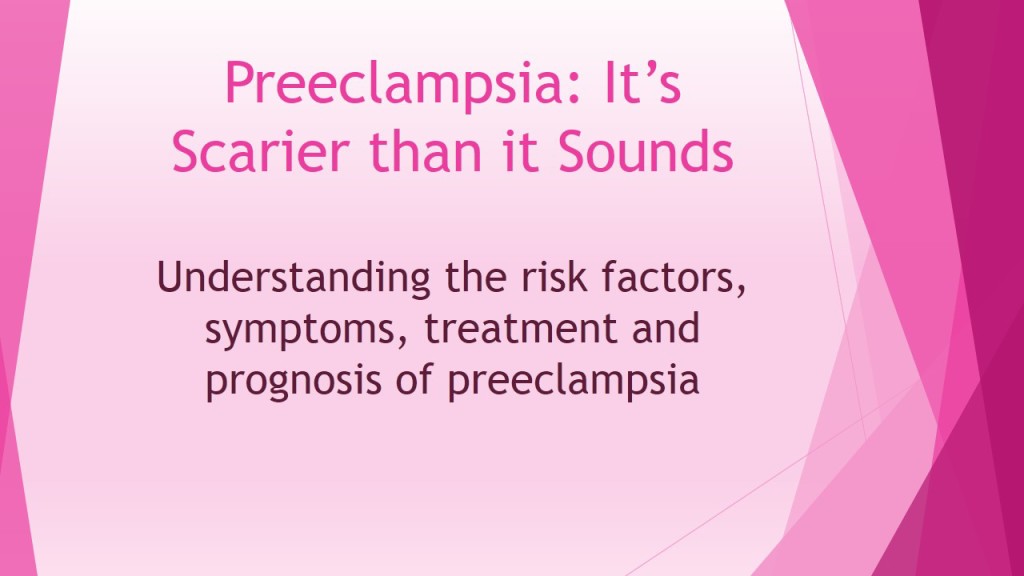
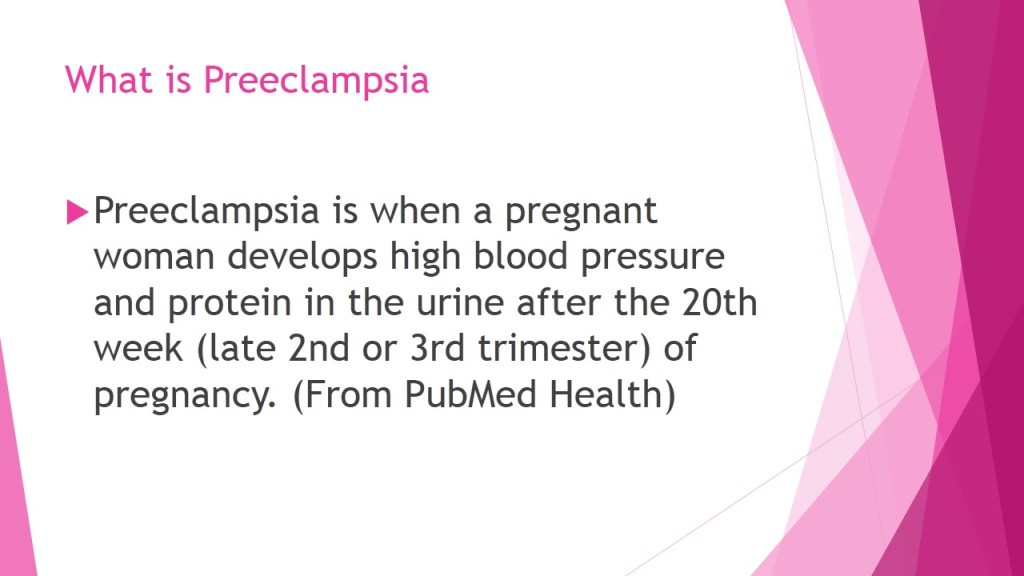
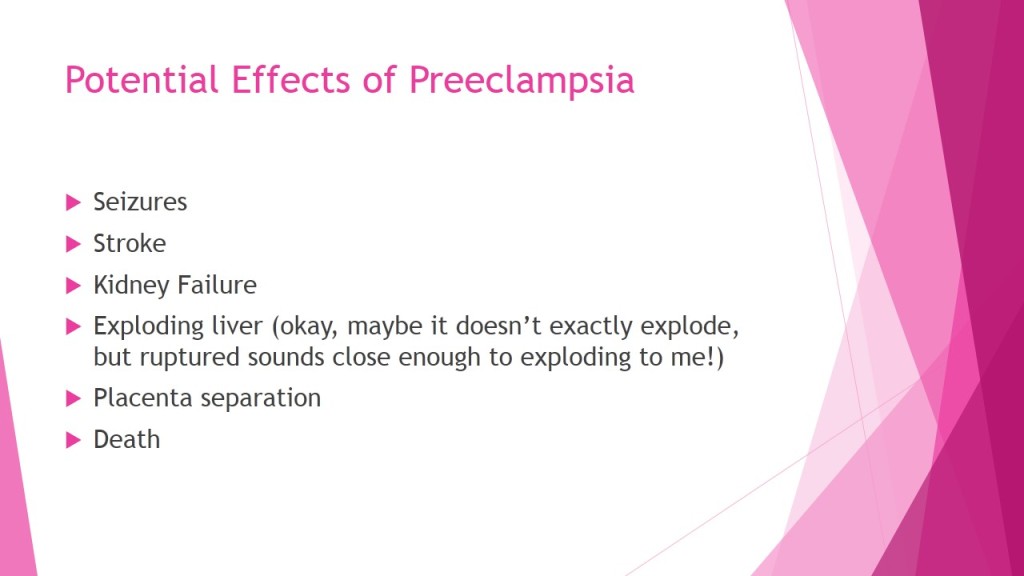
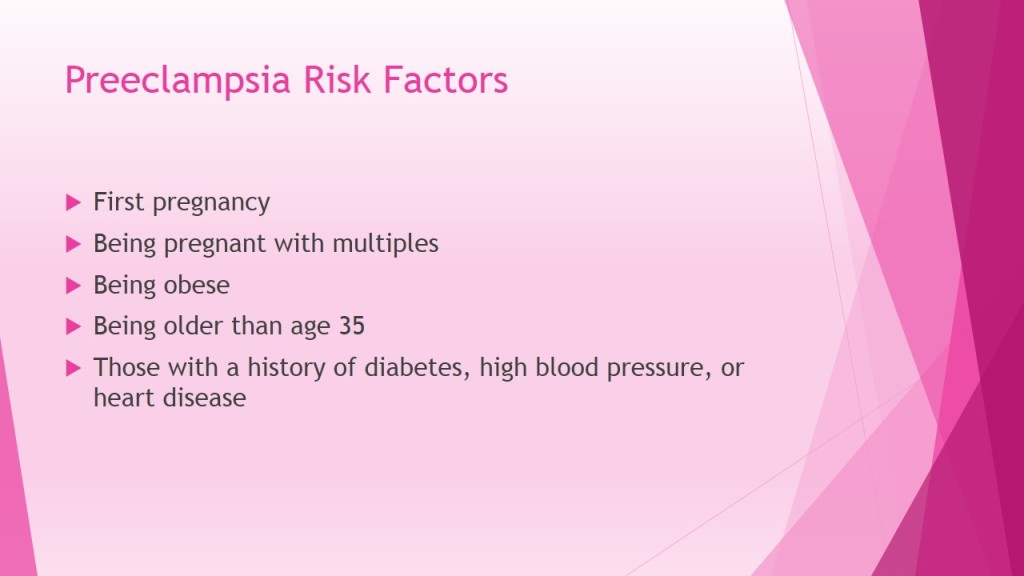
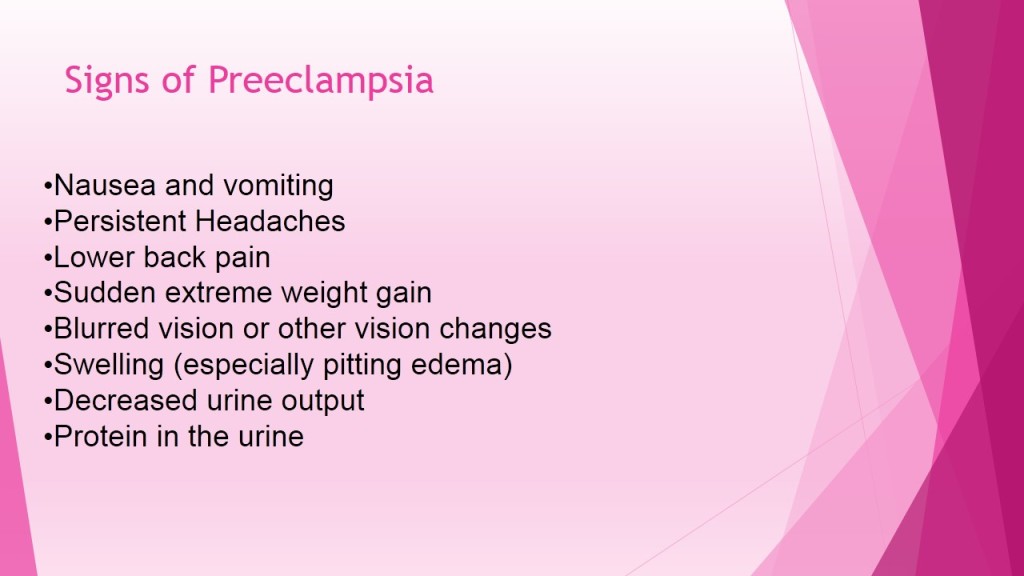
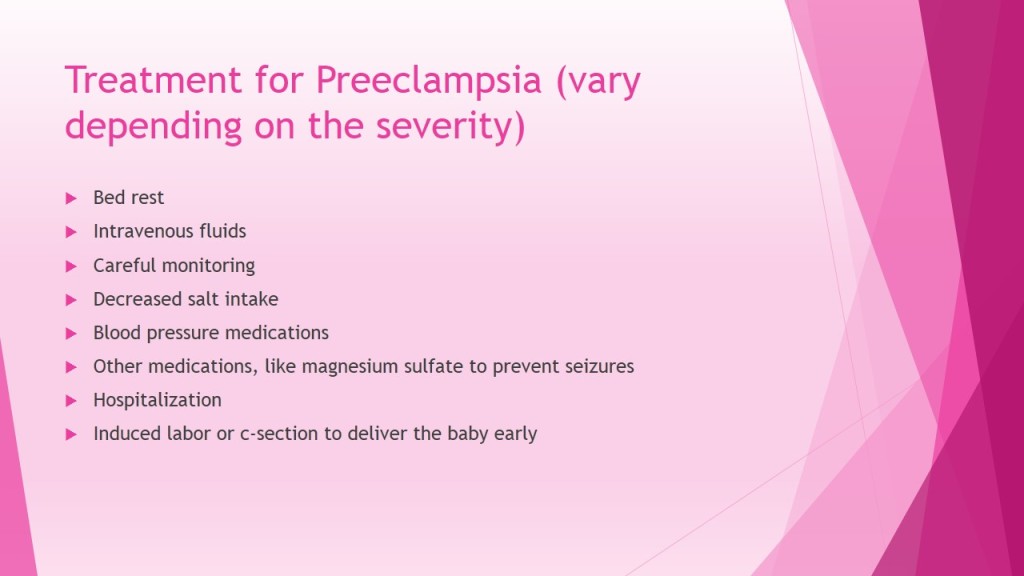


I developed preeclampsia in my final 3 weeks of pregnancy. I’ve always had low blood pressure so this wasn’t something I was prepared for! I ended up getting induced which turned into a terrible experience and almost resulted in losing my son. It was a very scary time in my life & I wish I would have known more about it before it happened to me. Thanks for getting the message out there so pregnant mommies know what to watch out for.
Thank you for sharing your preeclampsia story! I never, ever had high blood pressure before that moment, so it was a total shock to me too.
I have a blood disorder that had to be monitored weekly when I was pregnant. At the very beginning of my 3rd trimester I was at a hematology appointment and noticed that my blood pressure was all of a sudden higher than normal (I have always been around 110/70, but it was well above that). I went to my OB, had a 24 urine test, and was told that I had pre-e. My OB said it wasn’t serious enough to be induced at that point, but I was put on bedrest and had to go in every week for an ultrasound and a 24 urine test. I started to get bad headaches and pain in my ribs. Didn’t think much of it, but then around 36.5 weeks my vision changed. At my 37 week appointment I had a headache that wouldn’t go away and was seeing spots. They sent me to triage (in the same building as my OB’s office) where they tested my urine. My numbers were really high so they induced me right away. Pre-e is certainly no fun!
That is scary! I think one of the hardest things is that so many symptoms are already common in pregnancy. Like, I got headaches here and there, but nothing compared to the one I had two days before my son was born. The pain in the ribs, I would have thought it was from being kicked! It’s just so hard to differentiate between “normal” pregnancy pains and those that are actually a sign of something more serious.
Wow! This post really hit home. I had a high-risk pregnancy and ended up with preeclampsia after giving birth and being home for a week after already being in the hospital for over several days and in ICU because of severe hemorrhaging after giving birth and almost died. When I went home I kept having blurred vision and extreme headaches that I thought I was going to die (at this time my entire body was bloated) and when I went back for my 1 week checkup my blood pressure was so high that they admitted me then and put me on the magnesium drip and I stayed in the hospital for an entire week and when I went home after they finally got my blood pressure down I ended up with blood pressure medicine for about 6 months until they took me off.
This is SO SO important, thank you for posting about it!
naturally like your web-site however you have to take a look
at the spelling on quite a few of your posts. Several of
them are rife with spelling issues and I to find it very troublesome to tell the reality
nevertheless I’ll certainly come again again.